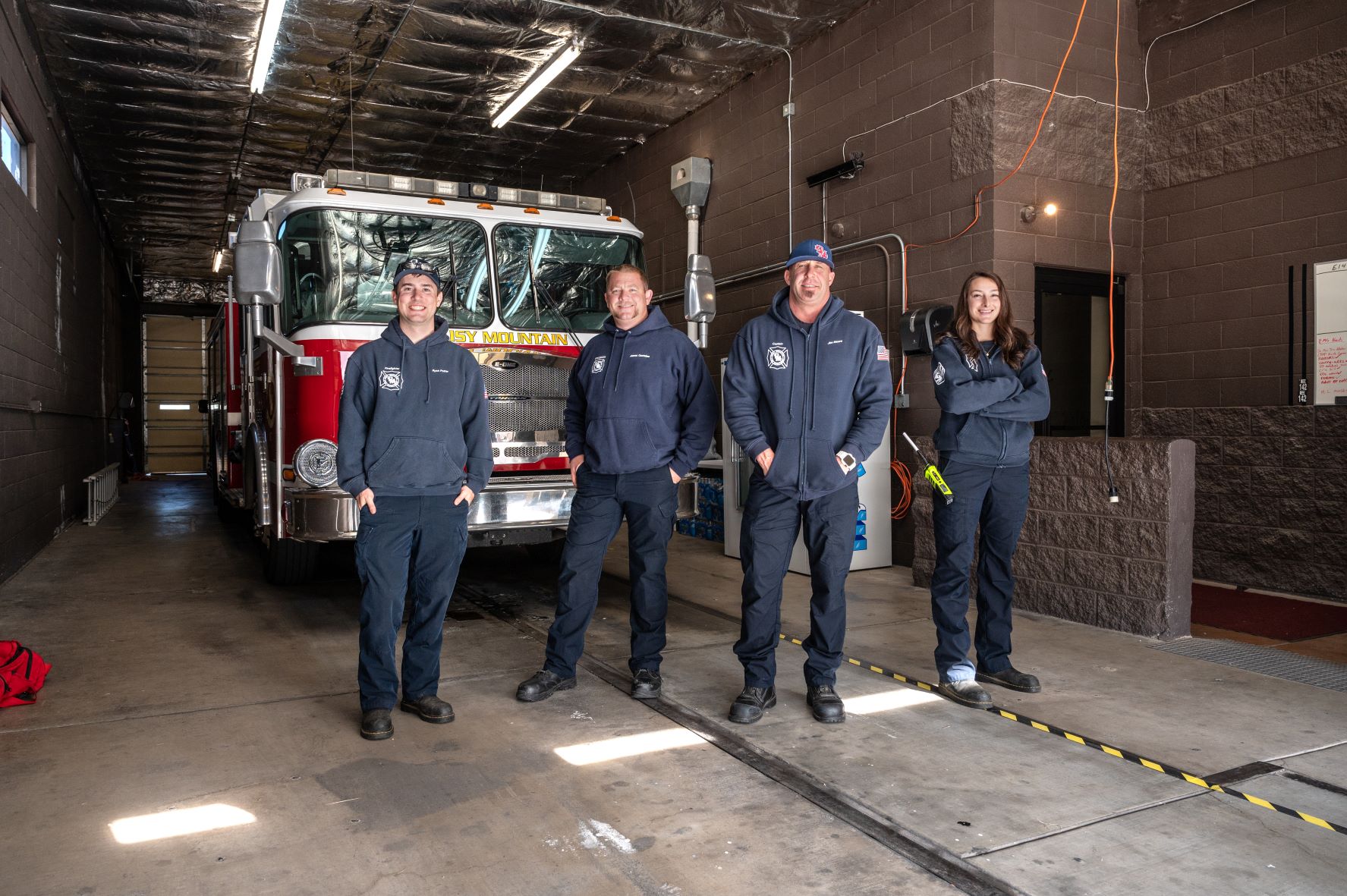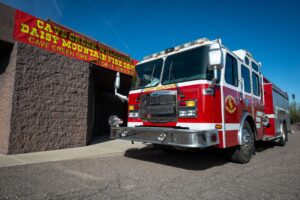Ready for Duty: Cave Creek Fire Station No. 1

Writer Joseph J. Airdo // Photography by Carl Schultz
Although we are still currently in the throes of winter, the weather will slowly but surely become warmer over the next few months. We will soon find ourselves trading in our sweaters, coats and boots for swimsuits, shorts and sandals.
However, our dreams of pool parties and outdoor barbecues are almost sure to be suppressed by nightmares involving the many downsides of the spring and summer seasons — the re-emergence of rattlesnakes, the scorching sunburns and, of course, the increased risk of wildfires.
Having two back-to-back major wildfire events in our memory from May 2020, it is impossible to enter into the warmer seasons without some concern and trepidation. However, at the encouragement of neighboring jurisdictions to increase fire protection and services, the town of Cave Creek now has a new resource at its disposal to decrease both response times and the potential negative impact of emergencies.
Council members voted late last summer to obtain a property to be used as the town’s first fire station and, in December, entered into a long-term agreement with Daisy Mountain Fire and Medical to provide emergency services at the location.
Daisy Mountain Fire and Medical’s public information officer Brent Fenton says Cave Creek Fire Station No. 1 — which is located on the same site at which Rural Metro Fire used to operate — is staffed 24 hours a day, 365 days a year, with personnel who can respond to everything from fire emergencies and heart attacks to automobile accidents and nosebleeds.
“The value that is added to the town of Cave Creek is immense with this fire station because Daisy Mountain Fire and Medical is part of the Regional Automatic Aid System,” says Fenton, noting that the system is a consortium of governmental fire departments/districts joined by an inter-governmental agreement wherein the participants agree to operationally act as one entity for the purpose of improved fire, rescue and emergency medical services.
Fenton says that the system essentially erases jurisdictional boundaries and allows the closest unit to address an emergency without delay.
“Sometimes there are coincidental multiple incidents going on at the same time within the same area,” he explains. “So if that [area’s] fire truck is on a call, you are going to get the next closest fire truck — and that does not matter whether it is a Daisy Mountain Fire and Medical unit, a Phoenix unit or a Scottsdale unit. They are going to be called automatically.”
Fenton says that in addition to decreasing response times, the system also provides access to a technical rescue team, which can do everything from high-angle rescue, swift water rescue, helicopter rescue and more.
“We also have a hazmat team for any kind of natural gas leak or hazardous materials issue,” he adds.



Originally a carwash before being utilized by Rural Metro Fire, the building that is now home to Cave Creek Fire Station No. 1 was renovated to meet Daisy Mountain Fire and Medical’s standards.
“With that update comes a state-of-the-art dispatch system,” Fenton says.
The dispatch system not only allows individual crew members to control notifications in their room — a necessity should an ambulance at some point be added to the current fire engine, water tender and brush truck — but also features a gradual volume to prevent any heart attacks or other medical issues that one may experience from being jolted out of their sleep in the middle of the night.
Moreover, Cave Creek Fire Station No. 1 is staffed with seasoned firefighters who are very familiar with the area.
“The bulk of the Daisy Mountain Fire District is very similar to what you will see in Cave Creek as far as the wildland urban interface and it being a more rural community with homes placed throughout the desert,” Fenton says. “So we are very familiar with running calls there, fighting fires there and having to utilize water tenders because water supplies can be sparse in those areas. We are specifically trained to run calls and fight fires in those areas.”
In other words, Daisy Mountain Fire and Medical is plenty prepared to meet the needs of the Cave Creek community. However, it is counting on the Cave Creek community to do its part to minimize the potential for that need — especially in the way of wildfires.
“We are in the middle of a dry winter but we did have some rain that will create new growth,” Fenton says. “And there is still a lot of growth that is there that has not burned. Plus, we still have the issue with globe chamomile — which is a very invasive species.
“We are encouraging folks toward the end of February and the beginning of March to really get out there and start creating defensible space on their properties. Get on top of those weeds while they are green. Do not wait until they turn brown to start clearing them.”
Fenton says that he has seen property owners far too often wait too long to begin their yardwork and inadvertently start a fire with their string trimmer or lawnmower.
“All it takes is one spark from a rock or something from the motors of those pieces of equipment to start a wildfire,” Fenton explains. “So do yourself a favor and get out there when the weather is nice.”
Property owners should clear debris a minimum of 30 feet away from all structures. Fenton says that 100 feet is ideal but acknowledges that that is not always possible — especially considering Arizona’s unique landscape and terrain.
Property owners should also trim any trees that may be near their structures, particularly those with branches above or touching the roof. This reduces the possibility of fire that is coming across the ground to be carried up into the canopy of the tree and spread to the roof of a structure.
And, as always, have a plan should an evacuation of the area be necessary.
Fenton says that the location of every fire station takes population density and call volume into consideration. He adds that Daisy Mountain Fire and Medical strives to respond to emergencies as quickly as possible.
“Less than 10 minutes is the goal but the average is between three and five minutes from calling 911 to some kind of fire apparatus showing up at your front door,” says Fenton, noting that another fire station is currently projected to open in 2024 on the west side of the town of Cave Creek near 24th Street and Cloud Road that will further decrease response times as the community continues to grow.
“We are very excited to be a part of the town of Cave Creek and to provide service to them. We are so appreciative to the town council and to the members of the community for all of their support. We received a very warm welcome from the community at the [Jan. 3] grand opening [of Cave Creek Station No. 1]. We feel very humbled and are very appreciative of everything that everyone has provided for us and all of the support that they have shown us.”
Cave Creek Fire Station No. 1
37042 N. Cave Creek Road, Cave Creek
daisymountainfire.org

